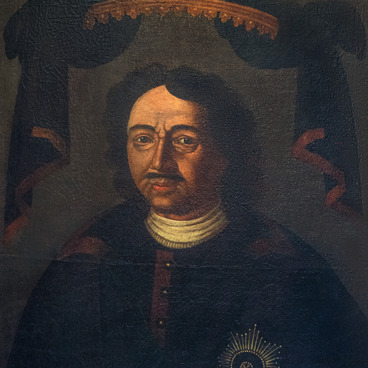In 1961, during the creation of the Arkhangelsk Museum of Fine Arts, several portraits of unknown artists were handed over from the Arkhangelsk Museum of Local Lore. All the canvases needed complex restoration. Some of them could be portraits of the Arkhangelsk governors. The museum employees conducted research and identified the names of people in the paintings.
This portrait depicts Timofey Tutolmin, one of the major enlightened figures of the Catherine era. He was born on January 3, 1740, in an old noble family. After graduating from the cadet corps, while still young, Tutolmin participated in the Seven Years’ War in 1756–1762 and the war with Turkey in 1768–1774. In 1775, he was appointed vice-governor of Tver. There, Tutolmin created the Noble Public School, where he taught the rules of education based on a sense of humanity, duty and honor.
After that, Tutolmin was appointed the governor of the Novorossiysk region, at the same time he received the 2nd Class Order of St. Vladimir. In 1784, he was appointed the ruler of the Arkhangelsk and Olonets viceroyalties. When the war with the Swedes broke out in 1788, he organized a militia from state peasants and ordered to send a company of volunteers and dragoons to Arkhangelsk. For his contribution to the victory, Catherine II awarded Tutolmin with the 1st Class Orders of Alexander Nevsky and St. Vladimir.
In the Arkhangelsk region, he wrote down historical, ethnographic and statistical information for a comparative dictionary. He was a passionate collector: his collection of portraits of the royal family and statesmen from the time of Peter I to the early 19th century included 90 paintings. In the mid-19th century, the royal portraits were transferred to the Romanov Gallery of the Winter Palace, while the rest were taken to the Gatchina Palace.
During the reign of Paul I, Tutolmin fell into disfavor: he was imprisoned in the Peter and Paul Fortress for a year and a half on a false charge. Then, Tutolmin was shelved and left for Moscow. Under Emperor Alexander I, he became the governor-general of Moscow in 1806. With the outbreak of the War of the Fourth Coalition, which later led to the Patriotic War of 1812, Tutolmin organized a levy in Moscow. For this, Alexander I awarded him the Order of St. Andrew the First-Called. He was later depicted wearing this order by an unknown artist.
This portrait depicts Timofey Tutolmin, one of the major enlightened figures of the Catherine era. He was born on January 3, 1740, in an old noble family. After graduating from the cadet corps, while still young, Tutolmin participated in the Seven Years’ War in 1756–1762 and the war with Turkey in 1768–1774. In 1775, he was appointed vice-governor of Tver. There, Tutolmin created the Noble Public School, where he taught the rules of education based on a sense of humanity, duty and honor.
After that, Tutolmin was appointed the governor of the Novorossiysk region, at the same time he received the 2nd Class Order of St. Vladimir. In 1784, he was appointed the ruler of the Arkhangelsk and Olonets viceroyalties. When the war with the Swedes broke out in 1788, he organized a militia from state peasants and ordered to send a company of volunteers and dragoons to Arkhangelsk. For his contribution to the victory, Catherine II awarded Tutolmin with the 1st Class Orders of Alexander Nevsky and St. Vladimir.
In the Arkhangelsk region, he wrote down historical, ethnographic and statistical information for a comparative dictionary. He was a passionate collector: his collection of portraits of the royal family and statesmen from the time of Peter I to the early 19th century included 90 paintings. In the mid-19th century, the royal portraits were transferred to the Romanov Gallery of the Winter Palace, while the rest were taken to the Gatchina Palace.
During the reign of Paul I, Tutolmin fell into disfavor: he was imprisoned in the Peter and Paul Fortress for a year and a half on a false charge. Then, Tutolmin was shelved and left for Moscow. Under Emperor Alexander I, he became the governor-general of Moscow in 1806. With the outbreak of the War of the Fourth Coalition, which later led to the Patriotic War of 1812, Tutolmin organized a levy in Moscow. For this, Alexander I awarded him the Order of St. Andrew the First-Called. He was later depicted wearing this order by an unknown artist.



